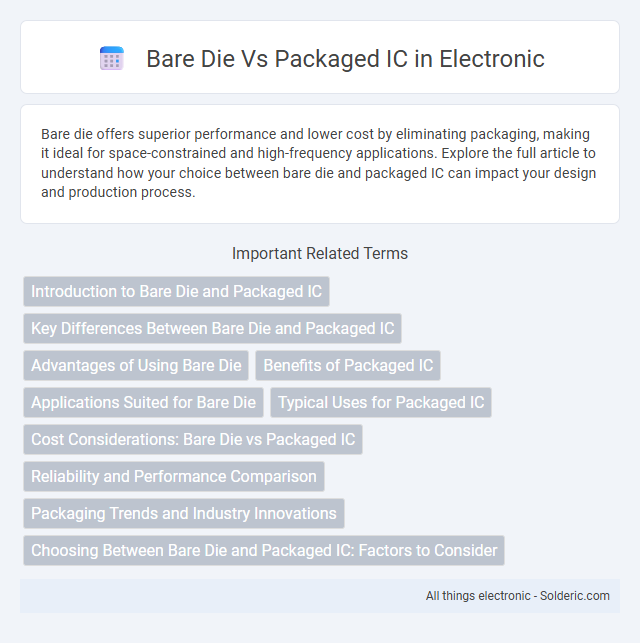Bare die offers superior performance and lower cost by eliminating packaging, making it ideal for space-constrained and high-frequency applications. Explore the full article to understand how your choice between bare die and packaged IC can impact your design and production process.
Comparison Table
| Feature | Bare Die | Packaged IC |
|---|---|---|
| Definition | Semiconductor chip without protective packaging | Integrated circuit enclosed in a protective package |
| Protection | Minimal; vulnerable to physical damage and contamination | High; offers mechanical protection and environmental shielding |
| Size | Smaller; allows higher density integration | Bulkier due to packaging materials |
| Thermal Performance | Better heat dissipation due to direct mounting | Reduced heat dissipation caused by packaging layers |
| Cost | Lower, no packaging costs | Higher, includes packaging and testing expenses |
| Usage | Used in high-performance, space-constrained applications | Common in mass-market electronic devices |
| Handling | Requires careful handling and specialized assembly | Easy to handle, standard installation processes |
| Reliability | Lower without protective enclosure | Higher due to protection from packaging |
Introduction to Bare Die and Packaged IC
Bare die refers to the unencapsulated semiconductor chip directly after fabrication, offering minimal packaging and reduced physical size, which enhances thermal performance and electrical characteristics. Packaged ICs encase the bare die within protective materials like plastic or ceramic, providing mechanical support, environmental protection, and standardized pin configurations for easier handling and integration. Understanding the differences between bare die and packaged ICs helps you select the appropriate component based on space, performance, and application requirements.
Key Differences Between Bare Die and Packaged IC
Bare die refers to an unpackaged semiconductor chip consisting solely of the silicon wafer with integrated circuits, while packaged ICs encase the die within protective materials and include external connections. Bare dies offer advantages in size reduction and thermal performance due to lack of packaging, but they require specialized handling and integration methods. Packaged ICs provide physical protection, ease of handling, and standard interfaces for circuit assembly, making them suitable for broader commercial applications.
Advantages of Using Bare Die
Bare die offers distinct advantages over packaged ICs, including reduced package size and weight, crucial for compact electronic designs and wearable devices. Enhanced electrical performance is achieved through shorter interconnections, minimizing parasitic capacitance and inductance, which improves signal integrity and speed. Cost efficiency arises from eliminating packaging processes, making bare die ideal for high-volume or embedded applications where space and performance are critical.
Benefits of Packaged IC
Packaged integrated circuits (ICs) provide enhanced protection against physical damage, environmental contaminants, and electrostatic discharge, significantly improving device reliability and lifespan. They offer standardized form factors and pin configurations, simplifying integration into printed circuit boards (PCBs) and reducing assembly time and errors. Your electronic designs benefit from improved thermal management and easier handling compared to bare die ICs, making packaged ICs ideal for efficient production and maintenance.
Applications Suited for Bare Die
Bare die are ideal for applications requiring minimal package size and enhanced thermal performance, such as aerospace, medical devices, and high-frequency communications. You can integrate bare die directly into multi-chip modules or system-in-package designs where space and weight savings are critical. These chips excel in environments demanding superior heat dissipation and electrical performance over packaged ICs.
Typical Uses for Packaged IC
Packaged ICs are commonly used in consumer electronics, automotive systems, and industrial equipment due to their ease of handling and protection from environmental factors. They offer reliable interconnection and standardized pin configurations, making them ideal for mass production and integration in circuit boards. Your designs benefit from packaged ICs when durability, thermal management, and simplified assembly are critical requirements.
Cost Considerations: Bare Die vs Packaged IC
Bare die offers lower upfront costs by eliminating packaging expenses, making it ideal for high-volume production where cost per unit is critical. Packaged ICs include encapsulation and protection, increasing durability but adding to manufacturing and material costs. You can reduce overall expenses by choosing bare die for cost-sensitive applications with controlled environments, while packaged ICs provide better reliability in general consumer products.
Reliability and Performance Comparison
Bare die ICs offer superior reliability due to the absence of packaging materials that can fail under thermal or mechanical stress, resulting in enhanced thermal conductivity and reduced signal parasitics for improved performance. Packaged ICs provide protection against environmental factors but may introduce slight delays and reduced thermal dissipation, potentially impacting long-term reliability and high-frequency operation. Your choice depends on the trade-off between the raw performance of bare die and the protective benefits of packaged ICs in your application.
Packaging Trends and Industry Innovations
Bare die offers superior thermal performance and reduced parasitic effects, driving demand in high-frequency and power-sensitive applications. Industry innovations emphasize advanced packaging techniques like fan-out wafer-level packaging (FOWLP) and embedded die solutions to enhance integration density and reliability. These trends support miniaturization and improved electrical performance, meeting the evolving needs of IoT, 5G, and automotive sectors.
Choosing Between Bare Die and Packaged IC: Factors to Consider
Choosing between bare die and packaged IC hinges on factors such as application environment, space constraints, and thermal management needs. Bare die offers advantages in size reduction, improved heat dissipation, and cost efficiency for high-volume production, while packaged ICs provide protection from physical and environmental damage, simplified handling, and ease of integration. Your decision should weigh reliability requirements, assembly capabilities, and overall system design to optimize performance and cost.
Bare die vs packaged IC Infographic

 solderic.com
solderic.com